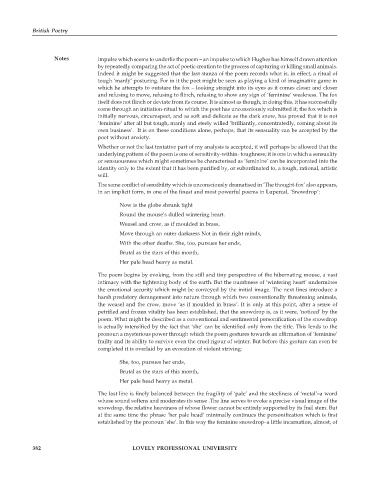Page 389 - DENG405_BRITISH_POETRY
P. 389
British Poetry
Notes impulse which seems to underlie the poem – an impulse to which Hughes has himself drawn attention
by repeatedly comparing the act of poetic creation to the process of capturing or killing small animals.
Indeed it might be suggested that the last stanza of the poem records what is, in effect, a ritual of
tough ‘manly’ posturing. For in it the poet might be seen as playing a kind of imaginative game in
which he attempts to outstare the fox – looking straight into its eyes as it comes closer and closer
and refusing to move, refusing to flinch, refusing to show any sign of ‘feminine’ weakness. The fox
itself does not flinch or deviate from its course. It is almost as though, in doing this, it has successfully
come through an initiation-ritual to which the poet has unconsciously submitted it; the fox which is
initially nervous, circumspect, and as soft and delicate as the dark snow, has proved that it is not
‘feminine’ after all but tough, manly and steely willed ‘brilliantly, concentratedly, coming about its
own business’. It is on these conditions alone, perhaps, that its sensuality can be accepted by the
poet without anxiety.
Whether or not the last tentative part of my analysis is accepted, it will perhaps be allowed that the
underlying pattern of the poem is one of sensitivity-within- toughness; it is one in which a sensuality
or sensuousness which might sometimes be characterised as ‘feminine’ can be incorporated into the
identity only to the extent that it has been purified by, or subordinated to, a tough, rational, artistic
will.
The same conflict of sensibility which is unconsciously dramatised in ‘The thought-fox’ also appears,
in an implicit form, in one of the finest and most powerful poems in Lupercal, ‘Snowdrop’:
Now is the globe shrunk tight
Round the mouse’s dulled wintering heart.
Weasel and crow, as if moulded in brass,
Move through an outer darkness Not in their right minds,
With the other deaths. She, too, pursues her ends,
Brutal as the stars of this month,
Her pale head heavy as metal.
The poem begins by evoking, from the still and tiny perspective of the hibernating mouse, a vast
intimacy with the tightening body of the earth. But the numbness of ‘wintering heart’ undermines
the emotional security which might be conveyed by the initial image. The next lines introduce a
harsh predatory derangement into nature through which two conventionally threatening animals,
the weasel and the crow, move ‘as if moulded in brass’. It is only at this point, after a sense of
petrified and frozen vitality has been established, that the snowdrop is, as it were, ‘noticed’ by the
poem. What might be described as a conventional and sentimental personification of the snowdrop
is actually intensified by the fact that ‘she’ can be identified only from the title. This lends to the
pronoun a mysterious power through which the poem gestures towards an affirmation of ‘feminine’
frailty and its ability to survive even the cruel rigour of winter. But before this gesture can even be
completed it is overlaid by an evocation of violent striving:
She, too, pursues her ends,
Brutal as the stars of this month,
Her pale head heavy as metal.
The last line is finely balanced between the fragility of ‘pale’ and the steeliness of ‘metal’–a word
whose sound softens and moderates its sense .The line serves to evoke a precise visual image of the
snowdrop, the relative heaviness of whose flower cannot be entirely supported by its frail stem. But
at the same time the phrase ‘her pale head’ minimally continues the personification which is first
established by the pronoun ‘she’. In this way the feminine snowdrop–a little incarnation, almost, of
382 LOVELY PROFESSIONAL UNIVERSITY

